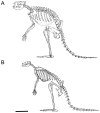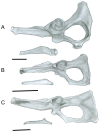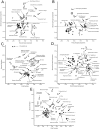Locomotion in extinct giant kangaroos: were sthenurines hop-less monsters?
- PMID: 25333823
- PMCID: PMC4198187
- DOI: 10.1371/journal.pone.0109888
Locomotion in extinct giant kangaroos: were sthenurines hop-less monsters?
Abstract
Sthenurine kangaroos (Marsupialia, Diprotodontia, Macropodoidea) were an extinct subfamily within the family Macropodidae (kangaroos and rat-kangaroos). These "short-faced browsers" first appeared in the middle Miocene, and radiated in the Plio-Pleistocene into a diversity of mostly large-bodied forms, more robust than extant forms in their build. The largest (Procoptodon goliah) had an estimated body mass of 240 kg, almost three times the size of the largest living kangaroos, and there is speculation whether a kangaroo of this size would be biomechanically capable of hopping locomotion. Previously described aspects of sthenurine anatomy (specialized forelimbs, rigid lumbar spine) would limit their ability to perform the characteristic kangaroo pentapedal walking (using the tail as a fifth limb), an essential gait at slower speeds as slow hopping is energetically unfeasible. Analysis of limb bone measurements of sthenurines in comparison with extant macropodoids shows a number of anatomical differences, especially in the large species. The scaling of long bone robusticity indicates that sthenurines are following the "normal" allometric trend for macropodoids, while the large extant kangaroos are relatively gracile. Other morphological differences are indicative of adaptations for a novel type of locomotor behavior in sthenurines: they lacked many specialized features for rapid hopping, and they also had anatomy indicative of supporting their body with an upright trunk (e.g., dorsally tipped ischiae), and of supporting their weight on one leg at a time (e.g., larger hips and knees, stabilized ankle joint). We propose that sthenurines adopted a bipedal striding gait (a gait occasionally observed in extant tree-kangaroos): in the smaller and earlier forms, this gait may have been employed as an alternative to pentapedal locomotion at slower speeds, while in the larger Pleistocene forms this gait may have enabled them to evolve to body sizes where hopping was no longer a feasible form of more rapid locomotion.
Conflict of interest statement
Figures











Similar articles
-
Divergent locomotor evolution in "giant" kangaroos: Evidence from foot bone bending resistances and microanatomy.J Morphol. 2022 Mar;283(3):313-332. doi: 10.1002/jmor.21445. Epub 2022 Jan 18. J Morphol. 2022. PMID: 34997777 Free PMC article.
-
Scaling of the ankle extensor muscle-tendon units and the biomechanical implications for bipedal hopping locomotion in the post-pouch kangaroo Macropus fuliginosus.J Anat. 2017 Dec;231(6):921-930. doi: 10.1111/joa.12715. Epub 2017 Oct 16. J Anat. 2017. PMID: 29034479 Free PMC article.
-
Hind limb scaling of kangaroos and wallabies (superfamily Macropodoidea): implications for hopping performance, safety factor and elastic savings.J Anat. 2008 Feb;212(2):153-63. doi: 10.1111/j.1469-7580.2007.00841.x. Epub 2007 Dec 13. J Anat. 2008. PMID: 18086129 Free PMC article.
-
Energetics and biomechanics of locomotion by red kangaroos (Macropus rufus).Comp Biochem Physiol B Biochem Mol Biol. 1998 May;120(1):41-9. doi: 10.1016/s0305-0491(98)00022-4. Comp Biochem Physiol B Biochem Mol Biol. 1998. PMID: 9787777 Review.
-
Scaling of avian bipedal locomotion reveals independent effects of body mass and leg posture on gait.J Exp Biol. 2018 May 22;221(Pt 10):jeb152538. doi: 10.1242/jeb.152538. J Exp Biol. 2018. PMID: 29789347 Review.
Cited by
-
Morphometric classification of kangaroo bones reveals paleoecological change in northwest Australia during the terminal Pleistocene.Sci Rep. 2022 Oct 29;12(1):18245. doi: 10.1038/s41598-022-21021-w. Sci Rep. 2022. PMID: 36309545 Free PMC article.
-
A bipedal mammalian model for spinal cord injury research: The tammar wallaby.F1000Res. 2017 Jun 15;6:921. doi: 10.12688/f1000research.11712.1. eCollection 2017. F1000Res. 2017. PMID: 28721206 Free PMC article.
-
An eye for a tooth: Thylacosmilus was not a marsupial "saber-tooth predator".PeerJ. 2020 Jun 26;8:e9346. doi: 10.7717/peerj.9346. eCollection 2020. PeerJ. 2020. PMID: 32617190 Free PMC article.
-
Differential developmental rates and demographics in Red Kangaroo (Osphranter rufus) populations separated by the dingo barrier fence.J Mammal. 2023 May 31;104(5):929-940. doi: 10.1093/jmammal/gyad053. eCollection 2023 Oct. J Mammal. 2023. PMID: 37800099 Free PMC article.
-
Changes in shape and cross-sectional geometry in the tibia of mice selectively bred for increases in relative bone length.J Anat. 2016 Jun;228(6):940-51. doi: 10.1111/joa.12459. Epub 2016 Mar 22. J Anat. 2016. PMID: 27003624 Free PMC article.
References
-
- Dawson TJ (1995) Kangaroos: Biology of the Largest Marsupials. Ithaca: Comstock Publishing Associates. 1–62 p.
-
- Helgen KM, Wells RT, Kear BP, Gerdtz WR, Flannery TF (2006) Ecological and evolutionary significance of sizes of giant extinct kangaroos. Aust J Zool 54: 293–303. Doi 10.1071/ZO05077
-
- McGowan CP, Skinner J, Biewener AA (2008) Hind limb scaling of kangaroos and wallabies (superfamily Macropodoidea): implications for hopping performance, safety factor, and elastic savings. J Anat 212: 153–163 Doi:10.1111/j.1469-7580.2007.00841.x - DOI - PMC - PubMed
-
- Prideaux GJ, Warburton NM (2010) An osteology-based appraisal of the phylogeny and evolution of kangaroos and wallabies (Macropodidae: Marsupialia). Zool J Linn Soc 159: 954–987 Doi:10.1111/j.1096-3642.2009.00607.x - DOI
-
- Kear BP, Cooke BN (2001) A review of macropodoid systematics with the inclusion of a new family. Mem Ass Australas Palaeontologists 25: 83–101.
Publication types
MeSH terms
LinkOut - more resources
Full Text Sources
Other Literature Sources

